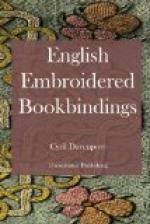In his right hand he holds a sword, and his tall black hat is on the ground beside him. On the ground towards the left is Isaac in an attitude of prayer, his hands crossed, with two sheaves of firewood. He wears a red coat with a small blue cape. The ground is green and brown chenille. Above Isaac is a gourd, and above this a silver ram caught in a bush, on a patch of grass indicated by green purl. The sky is occupied by a large cloud, out of which leans an angel with wings, the hands outstretched and restraining Abraham’s sword.
On the back are four panels, containing respectively from the top a butterfly, a rose, a bird, and a yellow tulip, all worked in needlepoint and applique. The pieces that are in high relief all over the book are edged with gold twist, and have moreover their counterparts under them closely fastened down to the satin. There are several gold spangles in the various spaces between the designs; the whole is edged with a strong silver braid, and there are two clasps with silver attachments.
Considering the high relief in which much of this work is done, the binding is in wonderful preservation, but many of the colours are badly faded, as it has been exposed to the action of light in one of the show-cases for many years. Although no doubt it is advisable to expose many treasures in this way, it must be admitted that in the case of embroidered books it is frequently, if not always, a cause of rapid deterioration, so much so that I should almost think in these days of good chromo-printing it would be worth the while of the ruling powers of our great museums to consider whether it would not be wiser to exhibit good colour prints to the light and keep the precious originals in safe obscurity, to be brought out, of course, if required by students.
[Illustration: 39—New Testament and Psalms. London, 1630.]
New Testament and Psalms. London, 1630.
Several small English books of the seventeenth century were bound ‘double,’ i.e. two volumes side by side, so as to open different ways (compare p. 38). Each of the books, which are always of the same size, has a back and one board to itself, the other board, between them, being common to both. As already stated, this form of book occurs rarely in canvas bindings, and it is of commoner occurrence in satin.
A design which is frequently met with is well shown in the case of a double specimen containing the New Testament and the Psalms, printed in London in 1630, and covered in white satin, measuring 4-1/4 by 2 inches, the ornamentation being the same on both sides. In the centre, in an oval, is a delicately worked iris of many colours in feather-stitch, the petals edged with fine silver cord. The oval is marked by a silver cord, beyond which are ornamental arabesques outlined in cord and filled in solidly, in high relief, with silver thread.
The backs are divided into five panels, containing alternately flowers in red, blue, and green silks, and star shapes in silver thread in high relief. Silver spangles have been freely used, but most of them have now gone; the edges of the leaves are gilt and gauffred in a simple dotted pattern. To the middle of the front edge of one of the boards is attached a long green ribbon of silk which wraps round both volumes.




